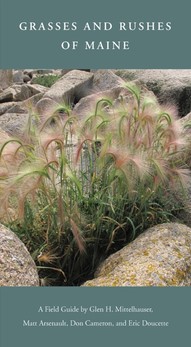
The Maine Natural Areas Program (DACF) partnered with the Maine Natural History Observatory and Stantec to fund and support the development of a user-friendly field guide to the grasses and rushes of Maine. This professional-quality guide, published by the University of Maine Press, bridges the gap between highly technical field manuals and generalized overviews and fosters better understanding and appreciation of these ecologically and economically important plant families.
Grasses and Rushes of Maine will enable the general public, natural resource professionals, land managers, scientists, students, and others to recognize over 200 species of grasses and rushes that occur in Maine, including rare and invasive species. The guide serves as a complement to the well-received Sedges of Maine – A Field Guide to Cyperaceae, released in 2013.
Grasses and rushes are dominant components of many ecosystems including freshwater wetlands, tidal marshes, woodlands, alpine areas, sand dunes, and managed fields. In fact, these two plant families contribute to a large portion of the flora in Maine, including a number of rare species.
This guide includes introductory material on the two plant families, a glossary that describes key characteristics, and a series of photo-driven keys that allow the user to quickly gain an understanding of an unknown species. Detailed descriptions for each species are accompanied by high resolution images of distinctive features, as well as discussions of the preferred habitat and statewide distribution.
The project is a collaborative effort between four authors, Don Cameron, botanist and ecologist with the Maine Natural Areas Program, Glen Mittelhauser, Director of the not-for-profit Maine Natural History Observatory in Gouldsboro, Matt Arsenault, senior botanist and ecologist with Stantec in Topsham, and Dr. Eric Doucette, assistant professor of biology at the Massachusetts College of Liberal Arts. Funding for the guide was generously provided by the Maine Outdoor Heritage Fund, Stantec, the Maine Natural History Observatory, and the Maine Natural Areas Program.
The book is available now through the Maine Natural History Observatory, University of Maine Press, or Amazon.com.
|